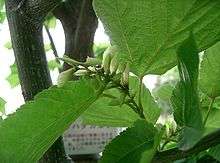Acer rufinerve
Acer rufinerve, the grey-budded snake-bark-maple,[3] redvein maple or Honshū maple (Japanese: ウリハダカエデ urihadakaede, "melon-skin maple"), is a maple in the snakebark maple group, related to Acer capillipes (Kyushu maple). It is native to mountains forests of Japan, on Honshū, Kyūshū and Shikoku.[4][5][6][7]
| Acer rufinerve | |
|---|---|
| Leaves | |
| Scientific classification | |
| Kingdom: | Plantae |
| Clade: | Tracheophytes |
| Clade: | Angiosperms |
| Clade: | Eudicots |
| Clade: | Rosids |
| Order: | Sapindales |
| Family: | Sapindaceae |
| Genus: | Acer |
| Section: | Acer sect. Macrantha |
| Species: | A. rufinerve |
| Binomial name | |
| Acer rufinerve | |
| Synonyms[2] | |
| |
The scientific and English names derive from the reddish down on the veins, the Japanese name from the bark pattern.[4][5][6][8]
It can be distinguished from the related Acer capillipes (Japanese, ホソエカエデ hosoekaede), with which it often occurs, by the green petioles, the rufous hairs on the underside of the leaves (contrasting with the hairless or only thinly hairy A. capillipes leaves), and in flowering earlier in spring at the same time as the leaves appear.[5]
Description

It is a small deciduous tree growing to a height of 8–15 m, with a trunk up to 40 cm diameter. The bark on young trees is smooth, olive-green with regular narrow vertical pale green to greyish stripes and small greyish lenticels; on old trees, it becomes rough and grey.
The leaves are three-lobed (occasionally five-lobed with two additional small basal lobes), double serrated, 8–16 cm long and 6–16 cm broad, matt to sub-shiny dark green above, paler below with small tufts of rusty hair on the veins when young, becoming glabrous when mature; the petiole is greenish (rarely pinkish), 3–5 cm long. The leaves turn to bright orange or red in the autumn.
The flowers are produced in racemes 10 cm long, each flower 8–10 mm diameter, with five yellow to greenish-yellow sepals and petals; it is dioecious, with male and female flowers on separate trees.
The fruit is a paired samara 2–3 cm long with rounded nutlets.
Cultivation
This is one of the most commonly planted snakebark maples, and is a hardy, fast grower. It does not display much variation as a species but a notable cultivar is 'Erythrocladum' with yellow-green in both its leaves and the stripes of its bark. Variegated cultivars include 'Albolimbatum' and 'Hatsuyaki'.[6][9]
References
| Wikimedia Commons has media related to Acer rufinerve. |
- The International Plant Names Index
- The Plant List, Acer rufinerve Siebold & Zucc.
- "BSBI List 2007". Botanical Society of Britain and Ireland. Archived from the original (xls) on 2015-01-25. Retrieved 2014-10-17.
- Kobe city: Acer rufinerve Archived 2007-11-07 at the Wayback Machine (in Japanese; google translation)
- Kanagawa Prefecture trees and shrubs: Acer rufinerve Archived 2009-10-24 at WebCite (in Japanese; google translation). Archived 2009-10-24.
- van Gelderen, C. J. & van Gelderen, D. M. (1999). Maples for Gardens: A Color Encyclopedia
- "Acer rufinerve". Germplasm Resources Information Network (GRIN). Agricultural Research Service (ARS), United States Department of Agriculture (USDA). Retrieved 2017-12-24.
- Rushforth, K. (1999). Trees of Britain and Europe. Collins ISBN 0-00-220013-9.
- Hort Net: 'Hatsuyaki'